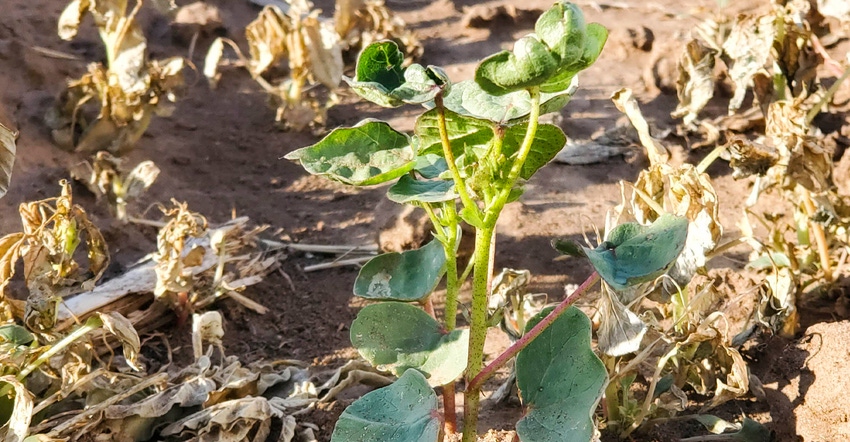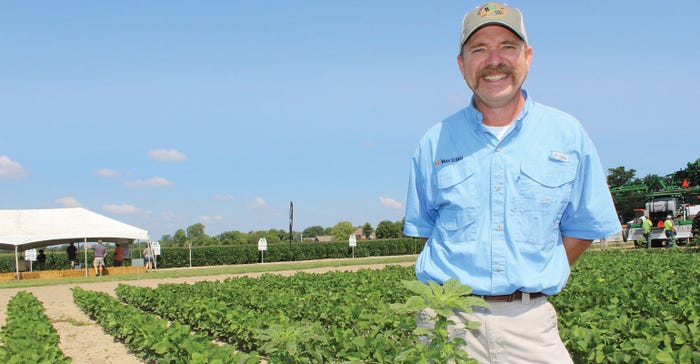
“Weed resistance management is more important than ever,” says University of Tennessee Institute of Agriculture Extension weed specialist Larry Steckel.
Signs of performance declines in Xtend and Enlist crops as well as well-documented resistance to glyphosate and other industry standard products help make his point.

Steckel teamed up with Scott Nolte, Texas A&M AgriLife Extension weed specialist, and Mark Nemec, MJV Consulting Service, to discuss issues with Xtend and Enlist crops and other emerging weed resistance issues at the Texas Plant Protection Association annual conference. The 32nd annual TPPA conference was virtual due to Covid-19 concerns.
Escaped grasses
Steckel said the most pressing issue in Tennessee Xtend cropping systems is not Palmer amaranth but escaped grasses, particularly junglerice. Barnyard grass and goose grass also pose control problems.
It’s not just resistance, he says, that plays a role. He said graduate student Clay Perkins’ doctoral research shows dicamba antagonism of glyphosate contributes to grass control breakdowns.
“But We can control these grasses,” Steckel said. “Don’t tankmix glyphosate and/or clethodim with dicamba.” He recommends making separate applications. “Apply glyphosate alone to control escaped grass.”
Steckel said he’s also seen some breakdowns with dicamba on Palmer amaranth.
“Tennessee is a no-till state, going back 20 years,” he said. Roundup Ready crops encouraged no-till planting and reliance on glyphosate. But Tennessee growers also used a lot of dicamba, Steckel said, and exposed Palmer amaranth to it.
“Last year, we had very little Palmer amaranth that had not been exposed to dicamba for a long time.” Control across many test locations has shown no more than 60% to 70% control. “That’s not good enough in most cases,” he said.
“Palmer amaranth control in 2020 often needed two applications; even then, sometimes control was sketchy. Always apply Enlist-One mixed with Liberty for most consistent Palmer amaranth control.”
He said pre-emergence herbicides remain an important part of a grass and weed control program. “Our number one recommendation is to start clean. We have good pre-emergence materials available.
“Also, cover crops help a lot. We can’t till in Tennessee,” he added. “Erosion is horrendous.”
Resistance or sensitivity?
Nolte said key weeds to watch for resistance in Texas are Palmer amaranth and waterhemp.
“If anybody asks me how to approach a resistance management system in cotton, I tell them to assume they have glyphosate resistance already. That helps drive the message for a better program to manage resistance.”
 Scott Nolte, Texas A&M AgriLife Extension weed specialist (Photo courtesy of Texas Plant Protection Association)
Scott Nolte, Texas A&M AgriLife Extension weed specialist (Photo courtesy of Texas Plant Protection Association)
He said Palmer amaranth is more prevalent in the Rolling Plains, the High Plains of the Panhandle, and the Southern part of the state. Waterhemp tends to occur more often in the Blacklands region and along the Upper Coastal area.
Recent tests in those location offer reason for concern, Nolte said. “We're not finding Palmer amaranth resistance yet, but we're looking at susceptibility.
“In the Rolling Plains and the High Plains, we're beginning to see a drop in susceptibility.
“It's not resistance,” Nolte said. “But we are seeing it be less sensitive since 48 of the 149 populations tested had survivors to a half X rate.”
He’s seen similar slippage with waterhemp in the Upper Coastal region. “We are starting to see populations with a little reduced sensitivity.
“None of these were resistant to dicamba,” he said. “But that doesn't mean we let our guard down again. You're in a good spot to start managing against the spread right now.”
Management is a multi-pronged affair. He recommends:
Rotate chemistry and mode of action. When we kill all the susceptibles, we leave the resistant weeds, and the more we use the same herbicide the more we select for resistance until there's nothing left but resistant plants.
Crop rotation.
Some tillage might aid weed management.
Apply soil herbicides.
Avoid anything that allows weed escapes to produce seed.
Hand hoeing might be an option.
He said weed resistance management can be expensive. “You have to think about the cost.” But the investment might pay.
“In heavy populations, applying a preemergent takes a lot of pressure off post applications. A good preemerge knocking out 75% of the emerging weeds means a lot fewer weeds to kill with a post emergent application. It buys time, so if you get rainfall that keeps you out of the field, the preemergent herbicide could give you an extra window.”
He says preemerge herbicide options in cotton include the DNAs, Prowl H2O and Treflan. “Those might require incorporation or rainfall, maybe another step.”
Timing
Timing matters, Nolte said.
“If you put down a pre, add a follow-up application about three weeks later. If you don't, make sure you're scouting and make a timely post application.”
Size matters, too. “Target one-inch-tall weeds. The label says four to six inches, but by the time you get around to spraying a four-inch weed, a Palmer amaranth or waterhemp can get beyond that four-inch size.”
He said growers have several options for post application herbicides, residuals and post directed or layby options.
Weed resistance, Nolte said, is not a temporary issue.
“We can't manage it like we do an economic threshold for insects. If we let those weeds go to seed, they can last for many years.”
Product stewardship will play a role in long-term success, he added.
“We have auxin herbicides for 2021 and beyond. We got them relabeled. But that doesn't mean we keep overusing them. Stewardship will be crucial for these herbicides to outlast the weeds.”
Back to basics
Nemec recommended basics and old-school techniques for herbicide resistant weeds.
 Mark Nemec, MJV Consulting Service, Hewitt, Texas. (Photo by Carol Nemec)
Mark Nemec, MJV Consulting Service, Hewitt, Texas. (Photo by Carol Nemec)
“Roundup Ready made things easy,” Nemec said. “We got a little bit lazy and that resulted in a resistance problem.”
He said going back to some basic practices, widely used before glyphosate tolerant varieties came along, makes sense.
The basics include preemergent herbicides. “We need to use pre-plant materials, the yellows. We have to use residuals early to prevent weed competition.”
He recommended follow-up applications, possibly Roundup or Liberty, two to three weeks after crop emergence.
“That usually works well in dryland production in the Blacklands,” he said. “You might need one more application in weedy spots or with rainfall. Irrigated acres might need one more residual or a layby treatment under the canopy. The old standby herbicides still work well,” he said.
Old school tech
He added that growers might consider using some old, possibly forgotten, equipment to add another dimension to resistant weed control.
“Some of these things haven’t been used in years and will need some paint and WD-40,” he said.
Hooded sprayers, for instance, will put effective herbicides under the crop canopy. Some of these units, he said, run slow, which is why farmers don’t like to use them.
They also add to weed control cost, requiring more time, more fuel and more wear on equipment.
“But some of these old units might have a place on some operations. Timing will be an issue and most of these old units cover only six or eight rows.
“If all else fails, you might consider hoeing,” Nemec said. “But it’s not for me.”
About the Author(s)
You May Also Like






